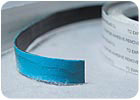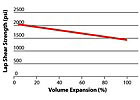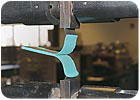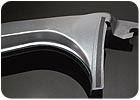A Double-Duty Cure
Have you ever wondered whether your curing ovens could make better use of all those British thermal units before venting the waste heat? With heat-activated structural epoxy adhesive tapes, they can. These tapes can combine components into assemblies, replace unsightly welds or rivets, join dissimilar metals without the threat of corrosion and provide local stiffening, all while being cured in an existing electrocoat (e-coat) or powder coat oven cure process.

Have you ever wondered whether your curing ovens could make better use of all those British thermal units before venting the waste heat? What if they could go beyond simply curing paint or powder to eliminating complete steps from your production process by performing both curing and joining operations, while simultaneously improving product quality?
With heat-activated structural epoxy adhesive tapes, they can. These tapes can combine components into assemblies, replace unsightly welds or rivets, join dissimilar metals without the threat of corrosion and provide local stiffening, all while being cured in an existing electrocoat (e-coat) or powder coat oven cure process. There are even electrically conductive versions available for applications requiring electromagnetic shielding, electrostatic discharge or paint coverage during e-coating.

Since then, baked epoxy structural tapes have been developed as an alternative to liquid- and paste-type adhesives for a variety of manufacturing applications, including such diverse products as furniture, all terrain vehicles and lawn and garden equipment. Newer generations of tapes provide higher bond strengths and ease of implementation into existing manufacturing processes. With no metering equipment requirements and no application mess, these heat-activated adhesives offer the flexibility to expand manufacturing capabilities with minimal challenges.

Why would anyone specify a lower strength tape with higher volume expansion? The expansion serves an important function in ensuring that the tape wets out to both surfaces properly, thereby allowing the adhesive to overcome any build variations in the joint and achieve a high-strength joint. A good rule of thumb is to use a tape with the lowest volume expansion that will overcome all build variations and tolerances
 The bond strength for baked epoxy structural tapes is typically measured as resistance to the failure modes of shear and peel. The tests used to obtain these properties are the lap shear and “T” peel tests (see Figure 2). Although lower in strength compared to steel spot welds of the same surface area, joints bonded with the baked epoxy structural tapes can be of significantly higher strength than welds because the taped joints are continuous, which increases the surface area of the bond. Table 2 (below) illustrates the impressive strength that can be achieved by using the epoxy tapes instead of resistance welds. Additionally, some tapes are weldable and can be used in conjunction with spot welds to produce seams or joints with exceptionally high strength.
The bond strength for baked epoxy structural tapes is typically measured as resistance to the failure modes of shear and peel. The tests used to obtain these properties are the lap shear and “T” peel tests (see Figure 2). Although lower in strength compared to steel spot welds of the same surface area, joints bonded with the baked epoxy structural tapes can be of significantly higher strength than welds because the taped joints are continuous, which increases the surface area of the bond. Table 2 (below) illustrates the impressive strength that can be achieved by using the epoxy tapes instead of resistance welds. Additionally, some tapes are weldable and can be used in conjunction with spot welds to produce seams or joints with exceptionally high strength.


Eliminating Drill and Rivet Operations. One manufacturer of large vehicles realized a cost savings by replacing a time-consuming drill and rivet operation with strips of baked epoxy structural tape. While a minimal number of rivets are still required to hold together the assembly while progressing through the oven, the cured tape delivers much greater strength than the mechanical fasteners.
Joining Dissimilar Metals. Another company found electrically non-conductive baked epoxy structural tapes to be an excellent way to mechanically attach components of dissimilar metals without the threat of future corrosion. Because the non-conductive tapes prevent electron transfer between dissimilar metals (often in the presence of electrolyte), they allow bonding of lightweight metals such as aluminum and magnesium (less noble on the galvanic series) with more common metals such as steel (more noble on the galvanic series). This capability allows designers the flexibility to use combinations of materials that are not possible with mechanical fasteners.
Improving Appearance by Eliminating Welds. In another application, a manufacturer was able to improve the appearance of a shelving unit by eliminating exposed resistance welds while simultaneously improving the overall stiffness of the end product.
For more information, visit www.llproducts.com.

Baked epoxy structural tapes are typically available in die cut shapes or on rolls that can be cut to length as needed by the operator.
Have you ever wondered whether your curing ovens could make better use of all those British thermal units before venting the waste heat? What if they could go beyond simply curing paint or powder to eliminating complete steps from your production process by performing both curing and joining operations, while simultaneously improving product quality?
With heat-activated structural epoxy adhesive tapes, they can. These tapes can combine components into assemblies, replace unsightly welds or rivets, join dissimilar metals without the threat of corrosion and provide local stiffening, all while being cured in an existing electrocoat (e-coat) or powder coat oven cure process. There are even electrically conductive versions available for applications requiring electromagnetic shielding, electrostatic discharge or paint coverage during e-coating.

Table 1.
Development of Heat-Activated Epoxy Tapes
In the 1970s, virtually all automakers adopted e-coating as a way to enhance corrosion protection for steel automobile bodies. In the ’80s, materials engineers discovered that heat-activated epoxy adhesives could be cured in an e-coat oven and could provide the strength required to replace resistance welds used to join sheet metal stampings. This discovery allowed the use of these adhesives in areas that were difficult to reach with bulky weld guns or where it was not permissible to put access holes in stampings for the weld gun tips.Since then, baked epoxy structural tapes have been developed as an alternative to liquid- and paste-type adhesives for a variety of manufacturing applications, including such diverse products as furniture, all terrain vehicles and lawn and garden equipment. Newer generations of tapes provide higher bond strengths and ease of implementation into existing manufacturing processes. With no metering equipment requirements and no application mess, these heat-activated adhesives offer the flexibility to expand manufacturing capabilities with minimal challenges.
Advantages Over Liquid Adhesives
In applications where strength is critical, baked epoxy structural tapes can provide a beneficial alternative to liquid and paste adhesives. They offer such key advantages as:- Ensuring high strength without the need for expensive mixing and metering equipment.
- Eliminating the need for an expensive breathing apparatus for operators during installation.
- Eradicating the concern about pot life.
- Preventing mess and reducing waste.
- Providing flexibility in where they are applied; they can even be integrated into components by the tape supplier.
- Providing excellent “wash out” resistance during cleaning and pretreatment.

Figure 1. The volume expansion of the tapes is inversely proportional to their lap shear strength.
Material Characteristics
Table 1 (above) illustrates the typical attributes and resulting advantages of baked epoxy structural tapes. Among the most important properties are bond strength and volume expansion. Figure 1 shows that these properties are inversely proportional; i.e., the higher the volume expansion, the lower the strength.Why would anyone specify a lower strength tape with higher volume expansion? The expansion serves an important function in ensuring that the tape wets out to both surfaces properly, thereby allowing the adhesive to overcome any build variations in the joint and achieve a high-strength joint. A good rule of thumb is to use a tape with the lowest volume expansion that will overcome all build variations and tolerances

Figure 2. The “T” peel test was performed on the baked epoxy structural tapes to evaluate bond strength.

Table 2.
Installation and Handling
Baked epoxy structural tapes are typically available in die cut shapes or on rolls that can be cut to length as needed by the operator. Many come with a non-sticky surface on one side to provide easy handling and installation by an operator wearing protective gloves. Additionally, many tapes are formulated to absorb and bond to metal stamping oils and drawing compounds. This capability promotes green-state adhesion and eliminates having to clean a substrate prior to applying a tape.Electrical Conductivity
To e-coat an assembly consisting of individual components, all components must be electrically connected to form an electrode. The e-coat or paint will only coat components that carry an electric current. Electrically conductive baked epoxy structural tapes can enable electrical conductivity between components and ensure e-coat paint coverage. Additionally, electrically conductive tapes can be used to electrically connect components that must provide for electrostatic discharge or even electromagnetic shielding, as in a Faraday Cage.
Joints bonded with the baked epoxy structural tapes can be of significantly higher strength than welds because the taped joints are continuous, which increases the surface area of the bond.
Application Advantages
The tapes can provide several cost-saving and performance-enhancing benefits, including eliminating drill and rivet operations, joining dissimilar materials and improving product appearance.Eliminating Drill and Rivet Operations. One manufacturer of large vehicles realized a cost savings by replacing a time-consuming drill and rivet operation with strips of baked epoxy structural tape. While a minimal number of rivets are still required to hold together the assembly while progressing through the oven, the cured tape delivers much greater strength than the mechanical fasteners.
Joining Dissimilar Metals. Another company found electrically non-conductive baked epoxy structural tapes to be an excellent way to mechanically attach components of dissimilar metals without the threat of future corrosion. Because the non-conductive tapes prevent electron transfer between dissimilar metals (often in the presence of electrolyte), they allow bonding of lightweight metals such as aluminum and magnesium (less noble on the galvanic series) with more common metals such as steel (more noble on the galvanic series). This capability allows designers the flexibility to use combinations of materials that are not possible with mechanical fasteners.
Improving Appearance by Eliminating Welds. In another application, a manufacturer was able to improve the appearance of a shelving unit by eliminating exposed resistance welds while simultaneously improving the overall stiffness of the end product.
Added Value
Heat-activated epoxy structural tapes have been widely accepted by the automotive community for a number of years. Recently, manufacturers of non-automotive products also have begun to realize the value provided by these adhesives. Whether cured in e-coat or powder coat ovens, these innovative tapes are helping companies improve their joining processes and reduce manufacturing costs.For more information, visit www.llproducts.com.
Looking for a reprint of this article?
From high-res PDFs to custom plaques, order your copy today!



